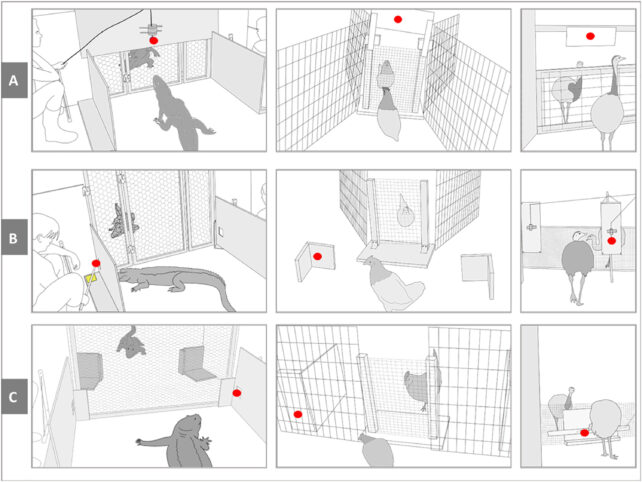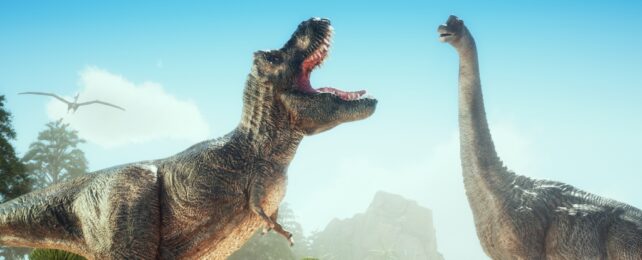Much like symbolically walking a mile in someone else's shoes, visual perspective-taking is 'seeing' through someone else's eyes: We follow someone's gaze to learn what caught their attention, or we may even try and work out what someone else is seeing if our view is blocked.
A new study by cognitive zoologists from Lund University in Sweden challenges the idea that mammals were the first to develop these advanced cognitive abilities.
Researchers' observations of alligators and birds suggest that visual perspective-taking, which humans learn around age two, may have originated in dinosaurs 60 million years earlier.
Only a few other species, mostly apes, some monkeys, wolves and dogs, and some bird species, have demonstrated visual perspectives. And not much is known about how it evolved.
Since mammals and birds are separated in evolution by 325 million years, yet evolved similar cognitive abilities independently, and visual perspective taking has been observed in so few species, researchers predicted it may have evolved multiple times.
In what they believe is the first study of its kind, the team compared paleognaths – the birds with brains most like their ancestral dinosaurs, with crocodilians – birds' closest living relatives. Birds and crocodilians are the only living representatives of archosaurs, a clade that includes pterosaurs and non-avian dinosaurs.
"Crocodilians are ideal models to study the evolutionary origins of cognitive capacities in birds. What they share most probably existed in the common ancestor of dinosaurs and crocodilians," explains Stephan Reber, a cognitive scientist at Lund University.
"If crocodilians lack an ability birds possess, it likely evolved in the dinosaur lineage after the split. This approach allows us to study the cognition of extinct species."
The 30 'study participants' included two large bird species: emus (Dromaius novaehollandiae) and greater rheas (Rhea americana), and two small bird species: elegant-crested tinamous (Eudromia elegans) and red junglefowl (Gallus gallus). They were joined by their crocodilian cousins: American alligators (Alligator mississippiensis).

Three 'gaze-following' experiments tested the animals' ability to follow gazes up, to the side, and geometrically behind a barrier.
Sometimes the experiments included one of their fellow species as a 'demonstrator' whose gaze they should follow, sometimes not, and they were tested with and without a stimulus in the form of a blue rubber ball or a laser dot.
The alligators did not show visual perspective-taking, although they did follow their demonstrator's gaze to places they could see. However, all the tested bird species clearly demonstrated visual perspective taking, shown by their ability to navigate a barrier to peer at a stimulus 'through their demonstrator bird's eyes'.
"Birds are commonly being overlooked when it comes to their cognitive skills," says the study's first author and Lund University cognitive zoologist Claudia Zeiträg.
"Our findings show that they do not only have several cognitive skills on par with those of apes but that their forebearers most likely had these skills long before they evolved in mammals."
Given the brain similarities of these birds and their non-avian ancestors, the scientists say this means the skill of visual perspective-taking could have developed even earlier in the dinosaur lineage.
It's less likely to have existed among the earliest dinosaurs, whose brains were more like those of alligators.
Researchers also observed the bird species engaging in a behavior called 'checking back', looking back at the demonstrator's eyes to 'recheck' their gaze when there was no stimulus, indicating they expect the gazer is looking at something and are surprised to find nothing there.
The only animals to exhibit this behavior in previous research are humans, apes, and monkeys.
If visual perspective-taking indeed emerged earlier in dinosaurs, it might explain the advanced visual capabilities of birds, including their evolutionary reliance on sight compared to most mammals.
Of course, with further research, we might learn that this ability to see through another's eyes is more widespread among mammals than we currently realize.
But even if that's the case, it's still likely the dinosaurs beat us to it when it comes to taking on another's perspective.
The research has been published in Science Advances.
